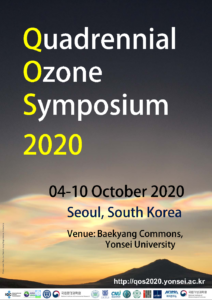 Download announcement
Download announcement
Find meeting webpage
Dear friends and colleagues,
On behalf of the International Ozone Commission (IO3C) and the Organizing Committee, we cordially invite you to attend the next Quadrennial Ozone Symposium (QOS), which will be held in Seoul, Korea from 6 to 10 October 2020. The symposium will be hosted at the Yonsei University at the center of Seoul Metropolitan City, Korea.
QOS 2020 will be an exciting international event for presenting and discussing recent research achievements and developments on ozone and related topics. Recently, a variety of new developments have taken place on all facets of atmospheric ozone, including its observation and impact on human health and ecosystems. Internationally renowned scientists, young scientists, and students will have a unique opportunity to present and discuss scientific issues, exchange ideas and establish collaborations.
Seoul offers excellent opportunities for a very attractive Symposium. It is a modern city with over 600 years of history as the capital of Korea. It offers many cultural opportunities in the metropolitan area and in the suburbs. You can meet old history of Chosun Dynasty and very popular modern K-pop. The local cuisine reflects the influences of the city’s history and diversity. Enjoy the local gastronomy at the numerous small places. Seoul is easily accessible by direct flights from many cities worldwide. Hotel prices are very competitive for all categories.
The weather in October is quite pleasant, with an average temperature of 13 ºC and precipitation probability of ~10%.
Sincerely,
QOS 2020 Local Organizing Committee
Important dates
Deadline for abstract submission (April 15th 2020)
Application for young scientist/students’ support (May 1-15th 2020)
Notification of student support (June 30th 2020)
Selection of oral/poster presentation (May 31st 2020)
Notification of oral/poster presentations (June 30th 2020)
Final program (July 31st 2020)
Deadline for Pre-registration (Aug 31st 2020)
